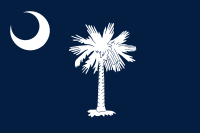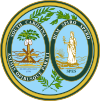The South Carolina Portal South Carolina (/ˌkærəˈlaɪnə/ ⓘ KARR-ə-LY-nə) is a state in the coastal Southeastern region of the United States. It borders North Carolina to the north, the Atlantic Ocean to the southeast, and Georgia to the southwest across the Savannah River. Along with North Carolina, it makes up the Carolinas region of the East Coast. South Carolina is the 40th-largest and 23rd-most populous U.S. state with a recorded population of 5,118,425 according to the 2020 census. In , its GDP was $213.45 billion. South Carolina is composed of 46 counties. The capital is Columbia with a population of 136,632 in 2020; while its most populous city is Charleston with a 2020 population of 150,227. The Greenville-Spartanburg-Anderson, SC Combined Statistical Area is the most populous combined metropolitan area in the state, with an estimated 2023 population of 1,590,636. South Carolina was named in honor of King Charles I of England, who first formed the English colony, with Carolus being Latin for "Charles". In 1712 the Province of South Carolina was formed. One of the original Thirteen Colonies, South Carolina became a royal colony in 1719. During the American Revolutionary War, South Carolina was the site of major activity among the American colonies, with more than 200 battles and skirmishes fought within the state. South Carolina became the eighth state to ratify the U.S. Constitution on May 23, 1788. A slave state, it was the first state to vote in favor of secession from the Union on December 20, 1860. After the American Civil War, it was readmitted to the Union on July 9, 1868. During the early-to-mid 20th century, the state started to see economic progress as many textile mills and factories were built across the state. The civil rights movement of the mid-20th century helped end segregation and legal discrimination policies within the state. Economic diversification in South Carolina continued to pick up speed during and in the ensuing decades after World War II. In the early 21st century, South Carolina's economy is based on industries such as aerospace, agribusiness, automotive manufacturing, and tourism. (Full article...)
Entries here consist of Good and Featured articles, which meet a core set of high editorial standards. Lawrence Eugene Doby (December 13, 1923 – June 18, 2003) was an American professional baseball player in the Negro leagues and Major League Baseball (MLB) who was the second black player to break baseball's color barrier and the first black player in the American League. A native of Camden, South Carolina, and three-sport all-state athlete while in high school in Paterson, New Jersey, Doby accepted a basketball scholarship from Long Island University. At 17 years of age, he began his professional baseball career with the Newark Eagles as the team's second baseman. Doby joined the United States Navy during World War II. His military service complete, Doby returned to baseball in 1946, and along with teammate Monte Irvin, helped the Eagles win the Negro League World Series. In July 1947, three months after Jackie Robinson made history with the Brooklyn Dodgers, Doby broke the color barrier in the American League when he signed a contract to play with Bill Veeck's Cleveland Indians. Doby was the first player to go directly to the majors from the Negro leagues. A seven-time All-Star center fielder, Doby and teammate Satchel Paige were the first African-American players to win a World Series championship when the Indians took the crown in 1948. He helped the Indians win 111 games (second-best in MLB history at the time) and the AL pennant in 1954, finished second in the American League Most Valuable Player (MVP) award voting and was the AL's RBI leader and home run champion. He went on to play for the Chicago White Sox, Detroit Tigers, and Chunichi Dragons before his retirement as a player in 1962. (Full article...)Selected article -Alexis Jordan (born April 7, 1992) is an American former singer, actress and dancer from Columbia, South Carolina. Jordan rose to fame as a contestant on the first season of America's Got Talent in 2006 at the age of 14. After being eliminated from the show, she began to upload cover songs to YouTube, which received millions of views. The exposure led Jordan to the attention of Norwegian production team Stargate and American rapper Jay Z, who both went on to sign her to their joint label, StarRoc. Jordan's debut single, "Happiness", was released in September 2010, and reached number one in the Netherlands and Norway, and also became a top-three hit in Australia and the United Kingdom. Jordan's debut self-titled album was released on February 25, 2011. "Good Girl" was released as Jordan's second single in February 2011. It debuted on the UK Albums Chart at No. 9 and on the Australian Albums Chart at No. 11. Jordan also featured on Sean Paul's single "Got 2 Luv U", which reached number one in Switzerland and Bulgaria. (Full article...)General images -The following are images from various South Carolina-related articles on Wikipedia. Did you know -
|
Topics
Categories
New articles
Rules | Match log | Results page (for watching) | Last updated: 2024-05-08 22:10 (UTC)
Note: The list display can now be customized by each user. See List display personalization for details.
- Joshua Crockett (edit | talk | history | links | watch | logs | tools) by John Foxe (talk · contribs · new pages (1)) started on 2024-05-08, score: 20
- 2024 Crown Royal Purple Bag Project 200 (edit | talk | history | links | watch | logs | tools) by Tyman9348 (talk · contribs · new pages (4)) started on 2024-05-06, score: 20
- Girard, Montana (edit | talk | history | links | watch | logs | tools) by KjjjKjjj (talk · contribs · new pages (24)) started on 2024-05-06, score: 20
- 2024 Buckle Up South Carolina 200 (edit | talk | history | links | watch | logs | tools) by MysticCipher87 (talk · contribs · new pages (3)) started on 2024-05-05, score: 20
- The Secret Life of Bees (musical) (edit | talk | history | links | watch | logs | tools) by HesioneHushabye (talk · contribs · new pages (16)) started on 2024-05-05, score: 40
- Robert D. Hatcher (edit | talk | history | links | watch | logs | tools) by Suslindisambiguator (talk · contribs · new pages (6)) started on 2024-05-04, score: 31
- Claire Jimenez (edit | talk | history | links | watch | logs | tools) by Ruth Bader Yinzburg (talk · contribs · new pages (3)) started on 2024-05-04, score: 40
- Jefferson Marion Long Jr. (edit | talk | history | links | watch | logs | tools) by MoviesandTelevisionFan (talk · contribs · new pages (72)) started on 2024-05-04, score: 60
- Daniel E. Winstead (edit | talk | history | links | watch | logs | tools) by MoviesandTelevisionFan (talk · contribs · new pages (72)) started on 2024-05-04, score: 40
- Stephanie Mitchem (edit | talk | history | links | watch | logs | tools) by Jaireeodell (talk · contribs · new pages (1)) started on 2024-05-03, score: 20
- 2000 South Dakota Democratic presidential primary (edit | talk | history | links | watch | logs | tools) by Memevietnam98 (talk · contribs · new pages (35)) started on 2024-05-02, score: 30
- 2024 World's Strongest Man (edit | talk | history | links | watch | logs | tools) by Brandon Downes (talk · contribs · new pages (1)) started on 2024-04-30, score: 20
- 1990 NCAA women's golf championship (edit | talk | history | links | watch | logs | tools) by Hey man im josh (talk · contribs · new pages (722)) started on 2024-04-30, score: 48
- Higgins House (edit | talk | history | links | watch | logs | tools) by DemonDays64 (talk · contribs · new pages (1)) started on 2024-04-30, score: 20
- Hampton County High School (edit | talk | history | links | watch | logs | tools) by Bernardgeorgeh (talk · contribs · new pages (1)) started on 2024-04-29, score: 20
- Frank P. Dwyer (edit | talk | history | links | watch | logs | tools) by Pjbermel (talk · contribs · new pages (2)) started on 2024-04-28, score: 20
- Marion D. McGowan (edit | talk | history | links | watch | logs | tools) by MoviesandTelevisionFan (talk · contribs · new pages (72)) started on 2024-04-28, score: 60
- Alfred W. Bethea (edit | talk | history | links | watch | logs | tools) by MoviesandTelevisionFan (talk · contribs · new pages (72)) started on 2024-04-28, score: 70
- William Bratton (Revolutionary War) (edit | talk | history | links | watch | logs | tools) by CaroleHenson (talk · contribs · new pages (7)) started on 2024-04-28, score: 36
- Nick Gargiulo (edit | talk | history | links | watch | logs | tools) by BeanieFan11 (talk · contribs · new pages (56)) started on 2024-04-27, score: 40
- Trajan Jeffcoat (edit | talk | history | links | watch | logs | tools) by Pealingofthebell (talk · contribs · new pages (3)) started on 2024-04-27, score: 30
- Steve Wadiak (edit | talk | history | links | watch | logs | tools) by BeanieFan11 (talk · contribs · new pages (56)) started on 2024-04-26, score: 36
- Ethan Petry (edit | talk | history | links | watch | logs | tools) by GPL93 (talk · contribs · new pages (12)) started on 2024-04-26, score: 40
- Mark Murphy Sings Mostly Dorothy Fields & Cy Coleman (edit | talk | history | links | watch | logs | tools) by CoralRad (talk · contribs · new pages (7)) started on 2024-04-26, score: 20
- Bluffton expedition (edit | talk | history | links | watch | logs | tools) by Ficaia (talk · contribs · new pages (4)) started on 2024-04-26, score: 40
- Kung-Yee Liang (edit | talk | history | links | watch | logs | tools) by Felida97 (talk · contribs · new pages (2)) started on 2024-04-24, score: 36
- Thomas H. Pope (edit | talk | history | links | watch | logs | tools) by ProfessorKaiFlai (talk · contribs · new pages (8)) started on 2024-04-24, score: 40
- Oscar Frank Thornton (edit | talk | history | links | watch | logs | tools) by MoviesandTelevisionFan (talk · contribs · new pages (72)) started on 2024-04-24, score: 60
Related portals
WikiProjects
Associated Wikimedia
The following Wikimedia Foundation sister projects provide more on this subject:
- Commons
Free media repository - Wikibooks
Free textbooks and manuals - Wikidata
Free knowledge base - Wikinews
Free-content news - Wikiquote
Collection of quotations - Wikisource
Free-content library - Wikiversity
Free learning tools - Wikivoyage
Free travel guide - Wiktionary
Dictionary and thesaurus













































